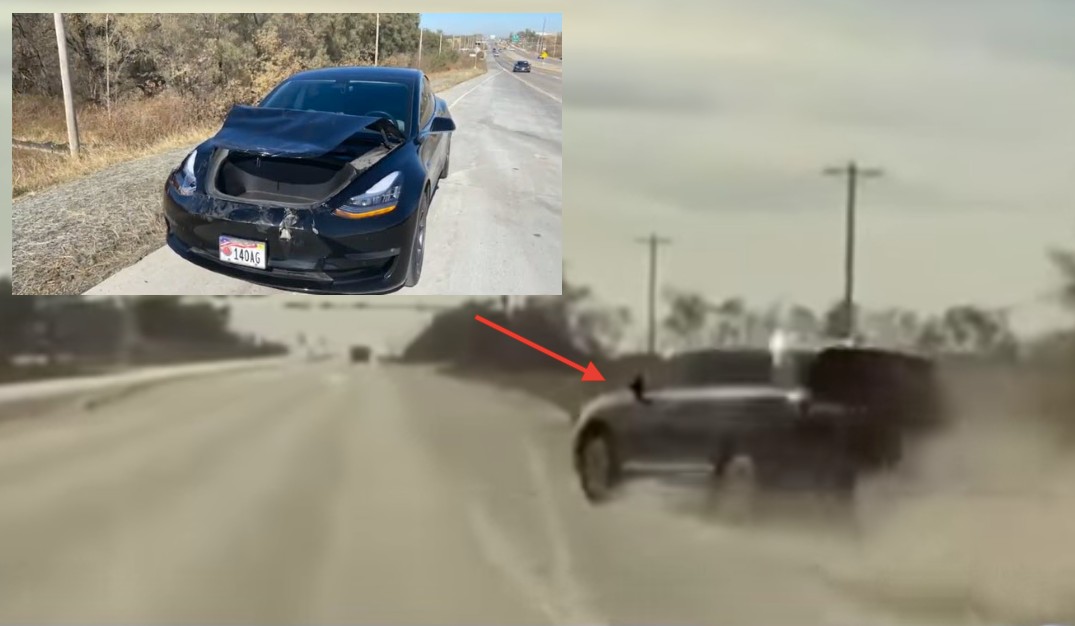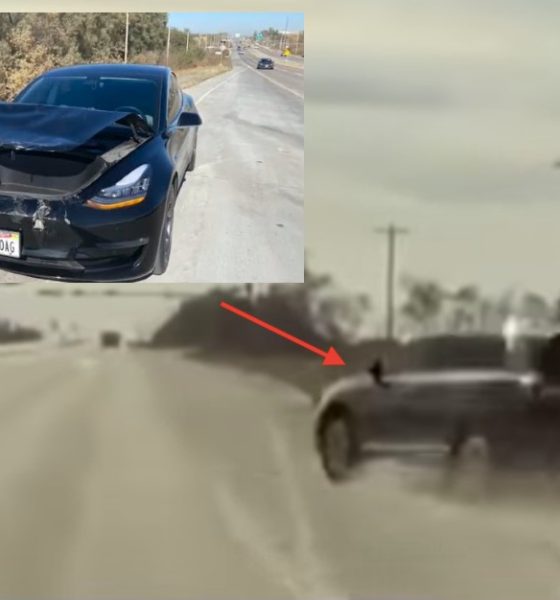

News
Tesla dashcam causes SUV driver to possibly lose license over road rage incident
After being stuck at home for almost two weeks, Omaha-based Tesla Model 3 owner Ken Woodward was looking forward to getting back to work. But before he could go back to his workplace, he needed to get another Covid-19 test. He took his trusty Model 3 to head over to the testing site, and things were completely normal. Unfortunately for Woodward, he was about a mile away from home when things took a turn for the worse.
At around 12:30 p.m. local time, the 40-year-old Tesla owner was driving near 204 and Center Streets when he encountered fellow 40-year-old Brian Frey, who was behind the wheel of an SUV. Unfortunately for the Model 3 owner, Frey was seemingly at a state where he is willing to hurt a fellow driver when he’s upset.
Frey was several car lengths behind the Model 3, with both the all-electric sedan and the SUV going around the speed limit. Woodward then came upon a red car that was driving much slower. Since he wanted to pass the slower car, Woodward merged into the adjacent lane in a standard overtaking maneuver.
This triggered something in the SUV driver. Speaking with local media after the incident, Woodward noted that he saw Frey throwing up his hands in the air like he was frustrated with the electric car driver. But that was just the beginning, as things were about to take a turn for the worse. Frey promptly accelerated hard, hitting the Model 3’s bumper. He followed it up by attempting to run the all-electric sedan off the road.
For good measure, and as Woodward was trying to keep his vehicle under control, Frey aggressively overtook the Tesla and slammed on his brakes. This resulted in the Model 3 crashing straight into the back of the SUV, throwing the massive vehicle forward.
“He forcefully whipped up behind me. He accelerated at me into my bumper, so that was the first hit. Then he pulled up next to me and forced me off the road completely almost into the guardrail going over Center Street. I regained my position back on the road. He overtook me and that’s when you can see in the video that he swerved in front of me and slammed on the brakes as hard as he could,” Woodward noted.
When authorities arrived on the scene, police were faced with conflicting accounts of the incident. Frey argued that it was the Tesla owner who tried to force him off the road before ramming his SUV from behind. Unfortunately for Frey, every single second of his road rage episode was recorded by the Model 3’s built-in dashcam feature. And once the footage was reviewed by the police, the authorities knew exactly what to do.
Deputies promptly ticketed Frey for willful reckless driving. And thanks to his road rage incident, he now stands to lose his license from 30 days to one year.
Speaking to local KETV News about the incident, Capt. Wayne Hudson with the Douglas County Sheriff’s Department highlighted that the Model 3’s dashcam feature proved to be the difference-maker in Woodward and Frey’s road rage case. “Having the video in the vehicle was beneficial to our investigation,” Hudson said.
Watch a news segment about the road rage incident in the video below.

News
Tesla FSD fleet is nearing 7 billion total miles, including 2.5 billion city miles
As can be seen on Tesla’s official FSD webpage, vehicles equipped with the system have now navigated over 6.99 billion miles.

Tesla’s Full Self-Driving (Supervised) fleet is closing in on almost 7 billion total miles driven, as per data posted by the company on its official FSD webpage.
These figures hint at the massive scale of data fueling Tesla’s rapid FSD improvements, which have been quite notable as of late.
FSD mileage milestones
As can be seen on Tesla’s official FSD webpage, vehicles equipped with the system have now navigated over 6.99 billion miles. Tesla owner and avid FSD tester Whole Mars Catalog also shared a screenshot indicating that from the nearly 7 billion miles traveled by the FSD fleet, more than 2.5 billion miles were driven inside cities.
City miles are particularly valuable for complex urban scenarios like unprotected turns, pedestrian interactions, and traffic lights. This is also the difference-maker for FSD, as only complex solutions, such as Waymo’s self-driving taxis, operate similarly on inner-city streets. And even then, incidents such as the San Francisco blackouts have proven challenging for sensor-rich vehicles like Waymos.
Tesla’s data edge
Tesla has a number of advantages in the autonomous vehicle sector, one of which is the size of its fleet and the number of vehicles training FSD on real-world roads. Tesla’s nearly 7 billion FSD miles then allow the company to roll out updates that make its vehicles behave like they are being driven by experienced drivers, even if they are operating on their own.
So notable are Tesla’s improvements to FSD that NVIDIA Director of Robotics Jim Fan, after experiencing FSD v14, noted that the system is the first AI that passes what he described as a “Physical Turing Test.”
“Despite knowing exactly how robot learning works, I still find it magical watching the steering wheel turn by itself. First it feels surreal, next it becomes routine. Then, like the smartphone, taking it away actively hurts. This is how humanity gets rewired and glued to god-like technologies,” Fan wrote in a post on X.
News
Tesla starts showing how FSD will change lives in Europe
Local officials tested the system on narrow country roads and were impressed by FSD’s smooth, human-like driving, with some calling the service a game-changer for everyday life in areas that are far from urban centers.

Tesla has launched Europe’s first public shuttle service using Full Self-Driving (Supervised) in the rural Eifelkreis Bitburg-Prüm region of Germany, demonstrating how the technology can restore independence and mobility for people who struggle with limited transport options.
Local officials tested the system on narrow country roads and were impressed by FSD’s smooth, human-like driving, with some calling the service a game-changer for everyday life in areas that are far from urban centers.
Officials see real impact on rural residents
Arzfeld Mayor Johannes Kuhl and District Administrator Andreas Kruppert personally tested the Tesla shuttle service. This allowed them to see just how well FSD navigated winding lanes and rural roads confidently. Kruppert said, “Autonomous driving sounds like science fiction to many, but we simply see here that it works totally well in rural regions too.” Kuhl, for his part, also noted that FSD “feels like a very experienced driver.”
The pilot complements the area’s “Citizen Bus” program, which provides on-demand rides for elderly residents who can no longer drive themselves. Tesla Europe shared a video of a demonstration of the service, highlighting how FSD gives people their freedom back, even in places where public transport is not as prevalent.
What the Ministry for Economic Affairs and Transport says
Rhineland-Palatinate’s Minister Daniela Schmitt supported the project, praising the collaboration that made this “first of its kind in Europe” possible. As per the ministry, the rural rollout for the service shows FSD’s potential beyond major cities, and it delivers tangible benefits like grocery runs, doctor visits, and social connections for isolated residents.
“Reliable and flexible mobility is especially vital in rural areas. With the launch of a shuttle service using self-driving vehicles (FSD supervised) by Tesla in the Eifelkreis Bitburg-Prüm, an innovative pilot project is now getting underway that complements local community bus services. It is the first project of its kind in Europe.
“The result is a real gain for rural mobility: greater accessibility, more flexibility and tangible benefits for everyday life. A strong signal for innovation, cooperation and future-oriented mobility beyond urban centers,” the ministry wrote in a LinkedIn post.
News
Tesla China quietly posts Robotaxi-related job listing
Tesla China is currently seeking a Low Voltage Electrical Engineer to work on circuit board design for the company’s autonomous vehicles.

Tesla has posted a new job listing in Shanghai explicitly tied to its Robotaxi program, fueling speculation that the company is preparing to launch its dedicated autonomous ride-hailing service in China.
As noted in the listing, Tesla China is currently seeking a Low Voltage Electrical Engineer to work on circuit board design for the company’s autonomous vehicles.
Robotaxi-specific role
The listing, which was shared on social media platform X by industry watcher @tslaming, suggested that Tesla China is looking to fill the role urgently. The job listing itself specifically mentions that the person hired for the role will be working on the Low Voltage Hardware team, which would design the circuit boards that would serve as the nervous system of the Robotaxi.
Key tasks for the role, as indicated in the job listing, include collaboration with PCB layout, firmware, mechanical, program management, and validation teams, among other responsibilities. The role is based in Shanghai.
China Robotaxi launch
China represents a massive potential market for robotaxis, with its dense urban centers and supportive policies in select cities. Tesla has limited permission to roll out FSD in the country, though despite this, its vehicles have been hailed as among the best in the market when it comes to autonomous features. So far, at least, it appears that China supports Tesla’s FSD and Robotaxi rollout.
This was hinted at in November, when Tesla brought the Cybercab to the 8th China International Import Expo (CIIE) in Shanghai, marking the first time that the autonomous two-seater was brought to the Asia-Pacific region. The vehicle, despite not having a release date in China, received a significant amount of interest among the event’s attendees.








